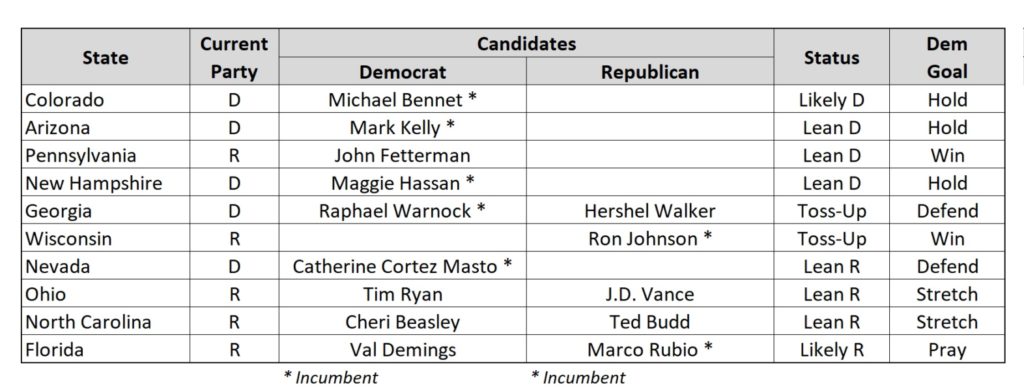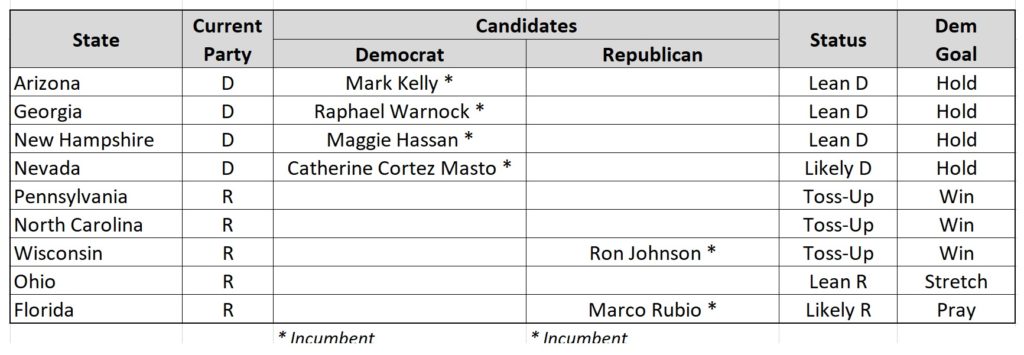While there’s no shortage of published opinions on numerous voting-related topics, I’ve seen few attempts to address the “Big Picture” overlap of these topics in terms of the 2022 elections. Since that intersection is my current cause for political anxiety, I thought I’d give it a brief shot.
Background
Let’s start with one simple given: The 2020 Presidential election was not stolen by Democrats. Biden won by a 74-vote margin in the Electoral College and, incidentally, by over 7 million popular votes. The Trump campaign filed at least 86 court cases challenging the election results. They won zero. There is not a single indication of any incidence of fraud that would have even come close to impacting the election.
Nevertheless, Republicans have continued to cling to the myth that they really won and that cheating Democrats managed to commit what their cult leader continues to call the “crime of the century”.
Am I generalizing about “Republicans” here? No, I’m not. To be sure, a few sane Republicans still remain and most of my own Republicans friends (hopefully) fall into that category. However, numerous independent polls show that a huge majority of Republicans sincerely believe that Trump actually defeated Biden. A recent Yahoo News/YouGov poll showed that fully 2/3 of Republican voters believe the election was stolen! Thus, Republican politicians continue their parade to Mar-a-Lago to kiss Trump’s ring and blindly accept the ludicrous election conspiracy theories of a sore loser.
Census & Redistricting
The 2020 Census and the associated reapportionment of both Congressional seats and Electoral College votes absolutely favors Republicans. Seven seats will shift between the states and, based solely upon how each state voted for President in 2020, Republicans will net one additional seat. That, however, isn’t nearly the whole story.
Concurrent, once-a-decade Congressional redistricting will have a much larger impact. This will be the first such effort conducted subsequent to the 2013 Supreme Court opinion that negated the pre-clearance of state district maps by the Department of Justice. Since such pre-clearance helped to preclude obvious racial gerrymandering, all bets are off this time. States will be able to redraw districts however they wish and, again, Republicans will have a clear advantage.
A FiveThirtyEight analysis shows that Republicans will have total control to redraw 43% of Congressional districts while Democrats will have total control to redraw only 17%. (The remainder are split-party or non-party decisions.)
For those that don’t have a calculator handy, redistricting alone will give Republicans a 2.5X advantage. Ouch.
State Election Laws
Abandoning efforts to attract voters with their policies, Republicans everywhere have decided that it’d be much easier to simply disenfranchise those Americans that might vote against them.
As of this writing, the Brennan Center has identified around 400 bills that have been introduced by Republicans in 49 states to restrict voting access. 18 states have already passed 30 such laws… and Republicans are just getting started.
The laws are quite diverse but are all specifically – and transparently – designed to decrease Democratic turnout. The laws include limiting the number of voting locations, restricting mail-in voting, making early voting more difficult, imposing more stringent voter ID requirements, making faulty voter purges more likely, enabling poll watchers to more easily intimidate voters, criminalizing water distribution to voters in long lines, etc.
[ Now, before anyone complains (and you know who you are): No, I am not simply repeating claims made by “liberal” media outlets. While such articles may have caught my initial attention, I’ve made a point to actually read the poorly written bills passed (or pending with a high probability of passage) in various state legislatures. When you’ve done the same, we can talk. ]
Here’s just a few egregious examples in just a few states:
- Texas: Texas has 254 counties, ranging in population from 4 million people (in Harris County which includes Houston) to 100 people (in Loving County on the New Mexico border). It would thus make a whole lot of sense to let each county run their own elections based on their distinct demographics and geography. However, the new state law will reduce the number of voting locations and voting machines allowed in large counties (all Democratic strongholds) and increase the number of voting locations and voting machines allowed in small counties (all Republican strongholds). [ Yes, Texas Democratic legislators have delayed the adoption of the draconian election laws by leaving the state. Unfortunately, the delay is just that. Republicans control the Texas state government and the laws will eventually pass. ]
- Georgia: Georgia will seriously reduce the number of ballot drop boxes available to absentee voters and further restrict access to those drop boxes. The changes will have a wildly disproportional impact in the most populous counties that voted overwhelming Democratic in 2020. In the four Atlanta-area counties where over a third of the state’s Black population resides, the number of drop boxes will be cut by 75%.
- Michigan: Michigan law will prevent the hiring of people to transport voters to the polls – which will have an obviously disproportional impact on low-income voters who tend to vote Democratic but who might need a ride to get to a polling location.
- Florida: Florida will now seriously restrict access to mail-in voting, despite a strong historic usage of such ballots. In 2016 and 2018, roughly a third of Florida voters cast mail-in ballots and more Republicans used that method than Democrats. In 2020, however, the trend switched to favor Democrats – causing Republicans to suddenly decide that mail-in voting was a bad idea.
State Election Officials & Election Certifications
There’s another trend that is even more disturbing than the above.
Numerous Republican election officials in Georgia, Michigan, Arizona, Nevada, and Pennsylvania were willing to defend the results of the elections they ran in 2020 – even while lamenting the fact that their party didn’t win. However, such public servants with the convictions to do their jobs regardless of the political fallout appear to be a dying breed.
In numerous states, people who vocally championed overturning 2020 election results by pure political fiat are looking to take over the state offices where they could do exactly that in future elections. The top state election official is generally the Secretary of State and 26 of those seats are up for election in 2022. Current Republican Secretary of State candidates include:
- Rep. Jody Hice (GA) – who led the congressional effort to overturn the 2020 Electoral College results.
- State Rep. Mark Finchem (AZ) – who is leading his state’s continuing, conspiracy-laden “audit”.
- Kristina Karamo (MI) – who publicly challenged her state’s election certification efforts.
- Jim Marchant (NV) – who sued to have his five-point 2020 Congressional election loss overturned.
In addition:
- Ruth Hughs (TX) was forced to resign as Secretary of State by Texas Republicans after she rightly claimed that she ran a “smooth and secure” 2020 election. By the way, Republicans handily won across the board in Texas – but apparently not by large enough margins to satisfy her party’s officials.
- Secretary of State Steve Simon (MN) has been under fire by his state’s Republican legislature for opposing voter restriction laws that he deems to be both unnecessary and harmful.
Far-right candidates will undoubtedly appear in many other states as we approach the 2022 elections.
In some cases, Republicans are going even further. For example, a provision in the new Georgia election law will give the Republican state legislature the power to directly intervene in the operation of local elections and even to unilaterally decertify any election results they don’t like.
With the presumed power to simply ignore or overturn any Democratic wins, Republicans won’t need to worry about changes to elections laws. In fact, they really won’t need to worry about elections.
Federal Election Laws
Since Republicans have mounted a frontal attack on voting rights at the state level, many Democrats are counting on a federal counter-attack. Reasonable legislation has certainly been proposed and has garnered significant media attention. After spending considerable time researching, summarizing, and opining upon these proposals (most notably the “For the People Act” and the “John Lewis Voting Rights Advancement Act”), I eventually deleted all of that text in favor of one simple conclusion:
State-level Democrats will get no federal help whatsoever with respect to election laws.
There is zero chance of any relevant election laws overcoming a Republican filibuster in the Senate and any Democratic pursuit of such legislation is nothing more than political theater that will waste considerable time, energy, and money.
2022 Impact
While all of the above will certainly have an impact on the 2024 Presidential election, the most immediate concerns are the 2022 elections in the U.S. House and the U.S. Senate. As we get closer to that election, I hope to attempt a more detailed analysis of the truly contested seats in both chambers. There will, however, be serious limitations to any predictive model given all of the changes to state election laws. All polls will likely be even more meaningless than before. That said, an overall conclusion is already abundantly obvious:
Democrats are screwed.
Republicans will redraw U.S. House districts to give their candidates a distinct advantage regardless of the wishes of the majority of a state’s voters. Republicans will continue to change election laws in competitive states to make it more difficult for Democratic-leaning constituents to vote. Republicans will block any federal efforts to protect voters’ rights. As a final backstop, numerous states will give their Republican legislatures – or a single Republican official – the power to overturn the results of any election that they still somehow manage to lose.
Damn.
My guess at the moment is that it will take a miracle for Democrats to retain control of the U.S. House in 2022. The game there will be to minimize the Republican margin of control to allow for a possible 2024 comeback. Control of the U.S. Senate in 2022 is tougher to predict – but it’s likely a toss-up.
What can Democrats do? Well, they first need to follow the old axiom of accepting the things they cannot change – and, unfortunately, that’s almost everything noted herein. Republicans may quite reasonably be relatively complacent on the ground in 2022 given the massive structural advantages that they are bestowing upon themselves. Thus, the only possible strategy for Democrats is to try to out-organize Republicans with voter registration, voter ID, and voter information initiatives.
Yeah, I know. After being silent on this blog for a long while, I come back with a thoroughly depressing post. Sorry ’bout that. My point is that Democrats need to quickly recognize that fairness is sadly irrelevant. The only path to retaining Democratic majorities is a very long, very rough, very expensive toll road.
Democrats need to stop complaining about it and start driving.


